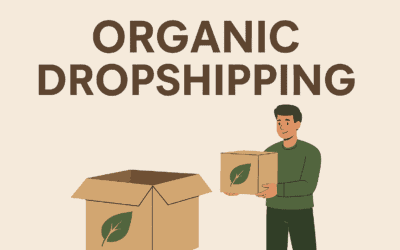
In the age of eCommerce, many aspiring entrepreneurs are exploring online business models that allow them to sell products without having to manufacture or stock them. Two of the most popular methods are dropshipping and reselling. While they may appear similar on the surface—both involve selling products you didn’t produce—they are fundamentally different in terms of logistics, investment, control, and long-term growth.
In this blog, we’ll explore what dropshipping and reselling are, how they work, their advantages and disadvantages, and which one is best suited to your goals in 2025 and beyond.
Table of Contents
ToggleWhat is Dropshipping?
Dropshipping is a fulfillment method where the retailer (you) doesn’t keep any products in stock. Instead, when a customer places an order, you purchase the item from a third-party supplier—usually a wholesaler or manufacturer—who then ships the product directly to the customer.
You act as the middleman, running the online store and managing customer relationships, while the supplier handles inventory and shipping.
Example:
You sell a phone case on your Shopify store for $20. Once someone buys it, you place the order with your supplier (say, for $10), and the supplier ships the item directly to the customer. You pocket the $10 profit.
What is Reselling?
Reselling is a model where you buy products in advance—either in bulk or as individual items—and then sell them for a markup. You manage your inventory, shipping, and packaging. Resellers often source products from wholesale suppliers, liquidation sales, thrift stores, or even manufacturers.
Example:
You purchase 100 pairs of branded sunglasses for $5 each and store them at your home or warehouse. You then list them on eBay or Amazon for $20 each. You handle shipping when a customer places an order.
Key Differences Between Dropshipping and Reselling
| Feature | Dropshipping | Reselling |
| Inventory | No inventory required | Inventory needed upfront |
| Shipping | Handled by the supplier | Handled by you |
| Startup Costs | Very low | Moderate to high |
| Profit Margins | Lower | Higher (if bought in bulk) |
| Control | Limited on product quality & delivery | Full control |
| Scalability | Easier to scale | Requires logistics planning |
| Branding | Harder to customize packaging | Easier with private labeling |
 Pros and Cons of Dropshipping
Pros and Cons of Dropshipping
Pros:
- Low Barrier to Entry: You don’t need to invest in inventory or warehousing.
- Wide Product Range: Easily test and sell hundreds of products.
- Location Independence: You can run your store from anywhere.
- Automation Potential: With tools like Oberlo, AutoDS, or DSers, much of the business can be automated.
Cons:
- Lower Margins: Suppliers take a cut, leaving you with thinner profits.
- Less Control: Shipping delays, quality issues, and stockouts are common.
- High Competition: Many sellers use the same suppliers and products.
- Customer Service Risks: You’re blamed for problems caused by the supplier.
Pros and Cons of Reselling
Pros:
- Higher Profit Potential: Buying in bulk reduces per-unit cost.
- Product Quality Control: You inspect and package items yourself.
- Faster Delivery: You control shipping, which can improve customer satisfaction.
- Brand Building: Greater ability to customize packaging and presentation.
Cons:
- Higher Upfront Costs: You must buy and store inventory.
- Storage Issues: Need space at home or invest in warehousing.
- Risk of Unsold Stock: If products don’t sell, you absorb the loss.
- Time-Consuming: You’re responsible for fulfillment, returns, and logistics.
Which Model Is More Profitable?
The profitability of dropshipping vs reselling depends on how you execute the business.
- Dropshipping allows you to start with minimal investment, but margins are tight. You need volume and efficient marketing to make it worthwhile.
- Reselling, on the other hand, offers better margins, especially when sourcing discounted or wholesale items. However, it carries more risk and requires cash flow.
Example Profit Breakdown:
| Item | Dropshipping | Reselling |
| Product Cost | $10 | $5 |
| Selling Price | $20 | $20 |
| Shipping | Included by the supplier | $3 |
| Net Profit | $10 – Fees | $12 – Fees |
While reselling appears more profitable, the initial investment and logistical efforts can make or break the model.
Popular Platforms for Each Model
Dropshipping Platforms:
- Shopify + DSers or AutoDS
- WooCommerce + AliDropship
- BigCommerce + Printful (for POD)
- Spocket, CJdropshipping, Zendrop
Reselling Platforms:
- eBay
- Amazon (FBA or FBM)
- Facebook Marketplace
- Poshmark (for fashion)
- Etsy (for collectibles or unique items)
Which Business Model Should You Choose in 2025?
Choosing between dropshipping and reselling comes down to your goals, budget, and willingness to take risks.
Choose Dropshipping If:
- You want to start an online business with very little money.
- You prefer low-risk, low-commitment testing.
- You want to focus on marketing and sales rather than operations.
- You’re just starting and want to learn eCommerce basics.
Choose Reselling If:
- You have capital to invest in inventory.
- You want more control over your product and brand.
- You’re okay with handling fulfillment or can use third-party logistics (3PL).
- You’re experienced in sales or have access to unique inventory sources.
Hybrid Approach: Can You Do Both?
Yes! Many successful sellers combine both models.
For example:
- Start with dropshipping to validate a product.
- Once you identify a winner, switch to reselling or bulk ordering for better margins.
- Use Print-on-Demand for custom items.
- Store fast-moving products locally and dropship slower-moving ones.
This hybrid strategy helps balance risk, improve customer satisfaction, and scale profitably.
Trends to Watch in 2025
As the eCommerce landscape continues to evolve, consider these trends:
- Faster Fulfillment Expectations: Consumers expect 2–3 day shipping. Resellers can offer this; dropshippers may struggle unless using local suppliers.
- Branding Matters: Private label dropshipping and white-label reselling are growing in popularity.
- AI & Automation: AI tools can optimize pricing, product research, and customer support.
- Sustainability Concerns: Eco-conscious consumers may prefer resellers who offer local or upcycled products.
- Niche Focus Wins: Both models work best in niche markets where competition is lower and customer loyalty is higher.
Conclusion: Dropshipping vs Reselling – Which One Wins?
There’s no one-size-fits-all answer. Dropshipping is ideal for beginners and low-risk testing, while reselling is better for those ready to invest and take control of their supply chain.
Here’s a final comparison:
| Factor | Best Model |
| Low startup cost | Dropshipping |
| Higher profits | Reselling |
| Less hassle | Dropshipping |
| More control | Reselling |
| Brand building | Reselling |
| Scalability | Dropshipping (early stage), Reselling (later stage) |
Ultimately, choose the model that aligns with your resources, goals, and risk tolerance. Or better yet—start small, test both, and build a strategy that combines the best of both worlds.
Need Help Starting Your eCommerce Business?
Whether you’re launching a dropshipping store or reselling products online, make sure to research your niche, use the right tools, and stay adaptable. Success in 2025 and beyond will go to those who innovate, automate, and build authentic brands.
Recent Posts
- Dropshipping vs Reselling: Which Model Suits Your Business Goals in 2025?
- Product Research Tools: The Ultimate Guide to Finding Winning Products
- Organic Dropshipping: The Future of Sustainable E-commerce
- Temu vs AliExpress for Dropshipping in 2025: Which is Better?
- Best Print on Demand Services in 2025
Related articles
Start the dropshipping store now! is proudly powered by WordPress
 WhatsApp
WhatsApp Pros and Cons of Dropshipping
Pros and Cons of Dropshipping


Recent Comments